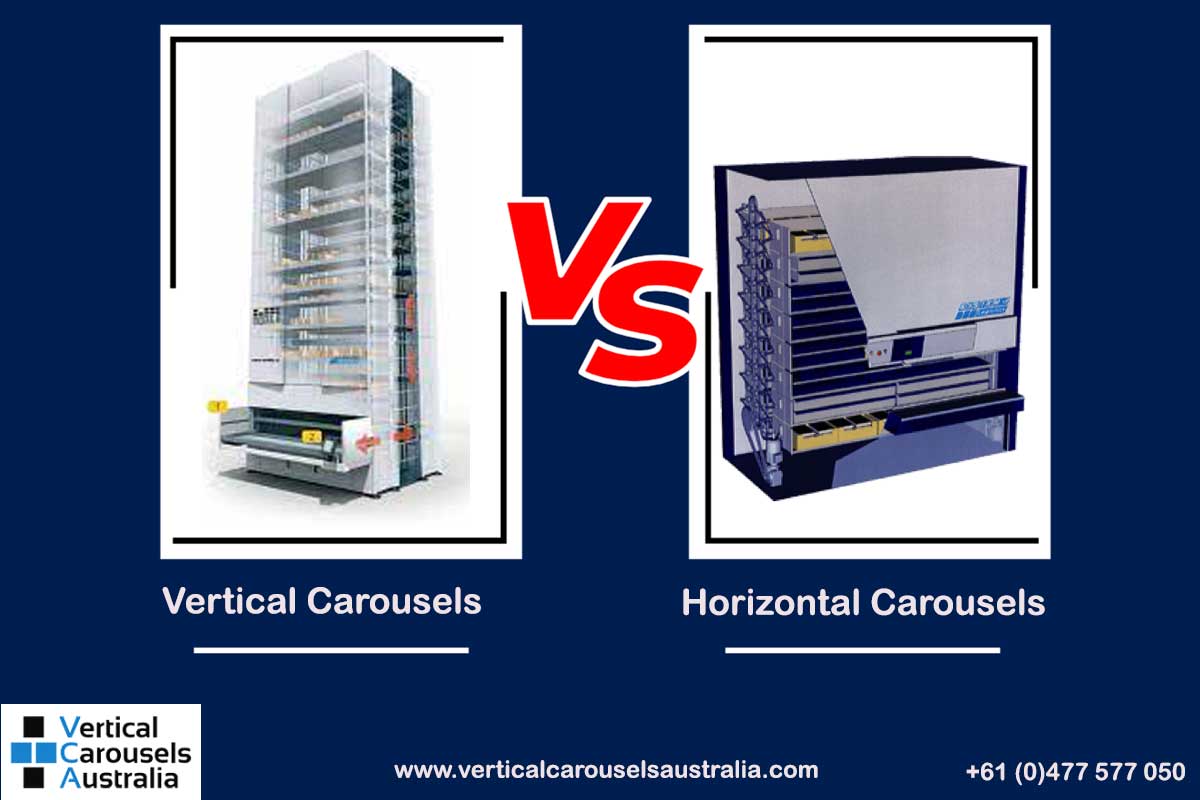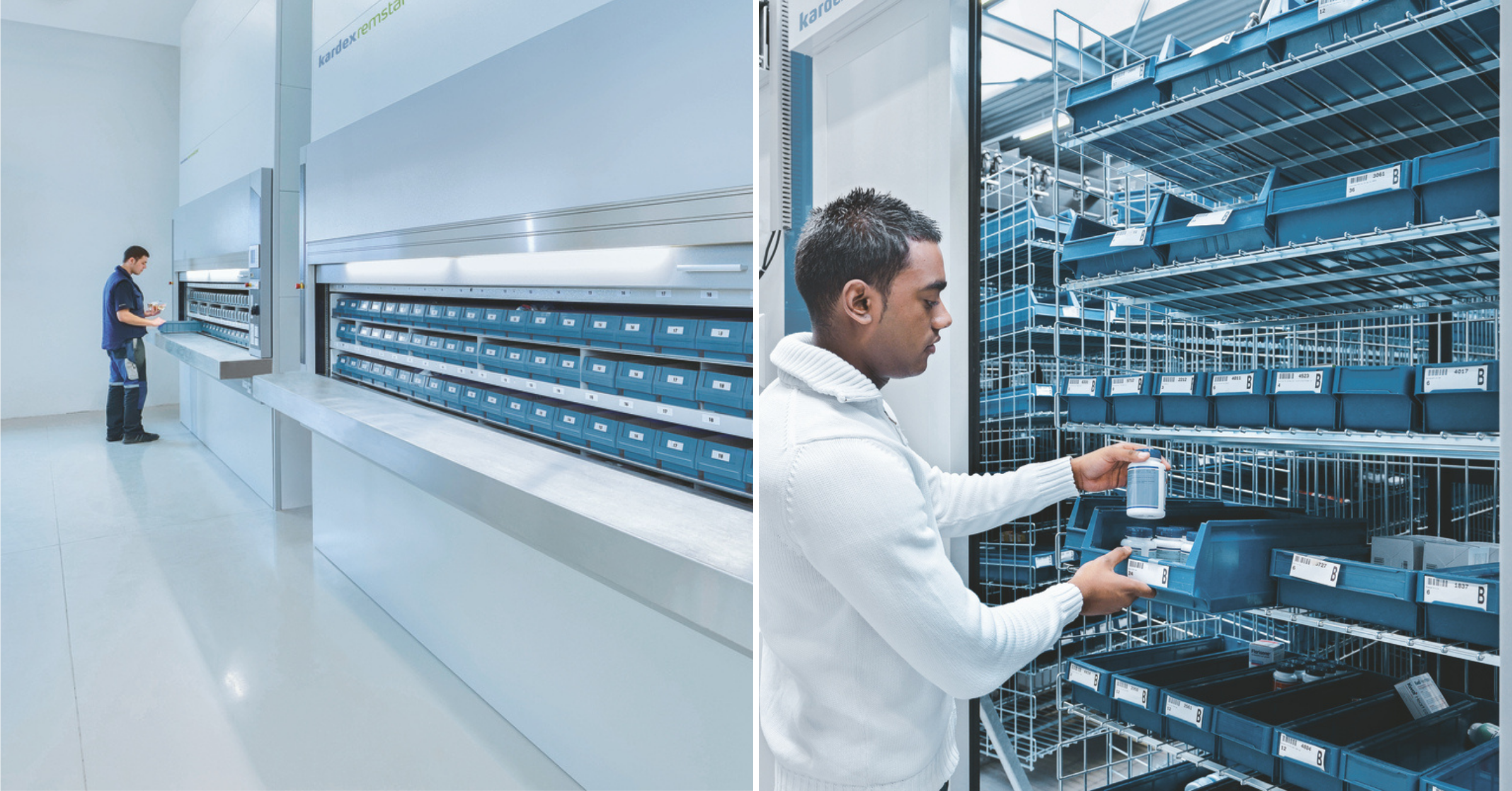
Vertical and Horizontal Carousels, despite their identical names, are vastly distinct automated storage & retrieval methods when examined closely. The most noticeable distinction is in the way the machines work. Vertical Carousels rotate vertically, whereas Horizontal Carousels rotate horizontally, as their names suggest. However, there is a LOT more to say about these two dynamic storage and retrieval machines.
Vertical Carousels storage solutions are a series of carriers attached to a chain drive at permanent places. A motor propels the carriers in a vertical loop around a track in both forward and reverses orientation, similar to how a Ferris wheel works. Goods are kept or retrieved through a work counter with an ergonomically positioned access opening.
Horizontal Carousels storage solutions are made up of revolving bins with shelves that are supported by an oval track. The carriers are propelled around the oval track horizontally by a motor housed inside the oval track, stopping at a periodically re-access point for storage or retrieval of items.
Both automated systems have been around since the 1950s and are frequently referred to as “ASRS giants,” despite the fact that nothing could be further from the truth. In truth, their long history and materials management expertise make them dependable storage devices. Over the years, a multitude of design changes and enhancements have ensured that these dependable dynamic storage units continue to provide modern, world-class manufacturing and distribution operations with better material handling efficiencies, including:
Both units are rectangular in shape, with horizontal carousels ranging from 19 to 153 feet long and vertical carousels varying from 6 to 14 feet wide by 4 to 5 feet deep. Because both carousels are accessed on the width dimension, vertical carousels are broad and shallow, while horizontal carousels are narrow and lengthy.
Another significant difference is unit height: Vertical storage carousels begin at just over 7 feet and can grow to 32 feet tall, whereas horizontal carousels begin at just over 7 feet and can grow to 13.5 feet tall. Horizontal carousels are an excellent choice for rooms with ceiling heights below 15 feet, but they can also be double (or triple) layered for higher ceilings, but more on that later.
The size and weight of the goods you need to store, followed by just how much you have, determine the unit’s final footprint.
Items are stored on carriers that are 49 to 144 inches wide by 17 to 24 inches deep on vertical storage carousels. The carrier is about 2 feet narrower than the whole unit, enabling room for the track on both sides of the carrier. The carrier’s height can range from 8 to 19 inches. Carriers can be partitioned further with additional shelves to accommodate smaller objects. Smaller parts can be organised in a high-density storage environment using totes, containers, boxes, or drawers.

Items are stored in carriers that dangle from an overhead track on horizontal carousels. Carriers can have a width of 24.5, 32.5, or 37 inches and a depth of 18, 22, or 24 inches. The height of the total unit is determined by the carrier height, which ranges from 6 to 12 feet. Carriers can be divided using intermediary shelves to provide specialised storage areas for totes, containers and boxes that house smaller objects.
Product weight can also play a role in deciding which automated storage system to use. Carousels can bear weights of up to 1,430 pounds per carrier on vertical carousels and 2,000 pounds per carrier on horizontal carousels. A few pounds can make all the difference in some circumstances.
Which one should you use now that you know the basics? Well, it’s not always so simple – but here are four things to think about :
When picking between an automated vertical and horizontal carousel, the physical area of your warehouse – notably the ceiling height – is a major factor. A horizontal carousel may be required due to a lower ceiling height than a vertical carousel. However, if space is at a premium and you need the most cubic capacity, a vertical carousel may be the preferable choice. Vertical storage carousels have a bit higher capacity than horizontal carousels, even at a lower ceiling height.
Another factor to consider is the system throughput requirement, which varies depending on the application. The optimal technology for you may be determined by how quickly you need to get the product out of the system. The system setup (layout and procedure), inventory locations (slotting), order profile (single line vs multi), picking technique (single order or batch picking) and other factors all influence throughput rates.
The consistency of your product mix is also a factor to consider when making a decision. For static product sizes, vertical carousels enable extremely dense storage. While intermediate shelves can be switched from housing 2-inch height products today to 4-inch tall products tomorrow, carrier size restrictions apply. Horizontal Carousels are easier to adapt to changing product mix than vertical carousels. Pick lights can be adjusted and carrier shelving can be added or removed as needed.
It all boils down to how much it costs and how much money you have available. Overall, per cubic foot stored, the horizontal carousel is the most cost-effective alternative. While price is always a factor, it’s never the most important factor – finding the greatest system to fulfill your demands now and in the future is crucial.
Your decision should be based on the available space, the application’s requirements and the cost. Request that a material handling expert evaluates your application, give you a cost comparison for both carousel storage solutions and assist you in determining your best optimum storage solution.